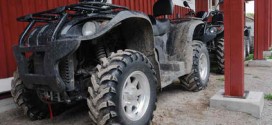
Aftermarket manufacturers offer dozens of fantastic and not so fantastic solutions to pick up where the manufacturer left off. We wanted to learn how to select an appropriate exhaust system so we sought one of the foremost authorities on ATV exhaust systems, and put a call into Kevin Berger, President of SuperTrapp Industries. An engineer by trade, Kevin has likely forgotten more about exhaust systems, and how they can positively (or negatively) affect an engines performance, then we will ever know.
Objectives
Kevin told us that the first thing you should do when selecting an exhaust system is identify their objectives. There are a several reasons to upgrade a stock exhaust system and each comes with certain tradeoffs. These objectives fall into one or 
- Additional power
- Modification of stock exhaust volume or note
- Appearance
- Replacement of a damaged factory exhaust
- Reduced weight
Once you haveidentified their objectives, the next thing to do is find exhaust systems that satisfy them. There are dozens of exhaust system manufacturers and many of them offer multiple product lines to solve specific problems. Some are designed to reduce noise (often at the cost of power), others are purely cosmetic, and others are all about maximizing power.
You may, however, have more than one use for your ATV. Let’s say, for instance, you use your ATV to hunt one weekend and the very next you find yourself carving razorbacks at the dunes. During the rider’s hunting expedition the goal will be to keep the ATV as quiet as possible. Conversely, while ripping through the dunes, you will want to squeeze as much power from your ATV as possible. A situation like this leaves you with two options. Select an exhaust system that comprimises power and silence or select a tunable exhaust system from a manufacturer like SuperTrapp. A tunable  exhaust system uses removable disks to vary the amount of backpressure. To reduce backpressure just add more disks.
exhaust system uses removable disks to vary the amount of backpressure. To reduce backpressure just add more disks.
In any case be mindful of volume. As civilization continues to encroach on our favorite riding areas, many of these riding areas are enforcing maximum volume limitations. These riding areas often limit maximum volume to 96 dB, so know the rules at any area you may wish to ride before you select your exhaust system.
When considering volume, Kevin from SuperTrapp offers a word of caution. Don’t assume that more noise equals more power. A poorly designed muffler will introduce turbulence in the exhaust flow which will actually impede airflow and reduce horsepower despite the fact that it has reduced backpressure.
It is also important to remember that too little back pressure can damage your engine. As backpressure is reduced your fuel/air mixture is leaned out which causes your engine to run hotter. The additional heat can damage your exhaust valves. Some people go to a drag race and see dragsters with straight pipes and assume that they should do it to their machines to maximize power. What they don’t consider is that the dragsters engine will probably be totally rebuilt when it has less than 10 miles on it so the mechanics don’t really care about long term durability. Since you are probably not going to rebuild your engine every 10 miles make sure you consider long term durability when you select your exhaust system.
Quality
Once you have nailed down your objectives and hopefully your choices, you need to consider quality.
The first thing you want to look at is material. Resistance to corrosion is a very important quality in an ATV exhaust system. Your muffler is very likely to be sand blasted, caked with mud and soaked in water; all of which reduce the longevity of any exhaust system. If you work with your ATV, you may introduce it to even more corrosive materials such as fertilizer or insecticides. many aftermarket mufflers are made of aluminum which is lightweight and somewhat resistant to corrosion. Some, however, are made of stainless steel which is a bit heaver and more expensive, but significantly more resistant to corrosion. The finish of a high quality muffler should be brushed or polished, which will maximize resistance to corrosion.
Another thing to consider is build quality. The finest materials in the world are worthless if they are tacked together with bailing wire and chewing gum. Some exhaust systems are constructed to hold their innards together with rivets and spot welds, which isn’t the best combination for a high-vibration, high-pressure component. Look for a fully welded exhaust system, which trades rivets for bolts in the areas that are meant to be used as attachment points or in areas where welding doesn’t work.
Other Items to Consider
Spark Arrestors – Make sure that the exhaust system you choose includes a USDA Division of Forestry approved spark  arrestor. Spark arrestors help prevent fires by keeping superheated materials from unexpectedly exiting your exhaust system.
arrestor. Spark arrestors help prevent fires by keeping superheated materials from unexpectedly exiting your exhaust system.
Carburetor Jets – When you alter the amount of backpressure provided by your exhaust system you may need to re-jet your carburetor to compensate. Make sure that the company you purchase your exhaust system from is willing to offer guidance on this because the jet size you need to select will vary significantly based on a number of factors including your ATV, the exhaust system you select and you altitude.
Don’t Skimp – Select a system from a reputable manufacturer that’s willing to invest in research and development. Any company can bend pipe into an approximate shape, slap a muffler on the end of it and call it an exhaust system, but a quality exhaust system is designed by engineers that ensure their product will actually improve the performance of your ATV. SuperTrapp for example, dyno tests every installation of every exhaust system they design, and will not release it to the market if it doesn’t meet strict criteria.
An upgrade to your exhaust system is a simple, fast and cost effective way to improve ATV performance. They can usually be installed in a couple of hours with common hand tools, and in most cases a well designed system can net a 10% improvement in power. They aren’t cheap, however. A quality exhaust system will cost at least a couple of hundred dollars so you want to make sure you have clear objectives and reasonable expectations when selecting your exhaust system.
 4x4Review Off Road Magazine
4x4Review Off Road Magazine


